Chances you, you’ve seen beautiful betta fish swimming around small cups in pet stores and wondered whether or not they’d make great pets, either for yourself or for your kids.
They’re a freshwater fish native to Southeast Asia, nicknamed the Siamese fighting fish due to their feisty nature. Due to their popularity, you can find them swimming happily in homes around the world.
While they are an aggressive fish, betta fish can make excellent pets for the right people. However, they require specific care to keep them happy, healthy, and living for as long as possible.
An introduction to “Siamese fighting fish”
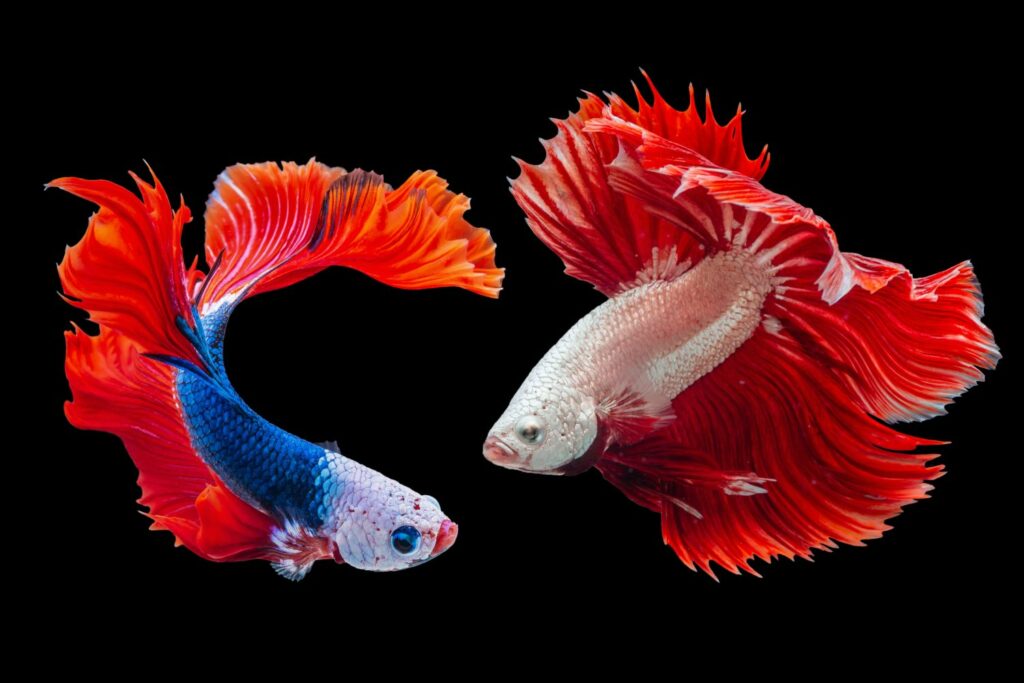
Betta fish are commonly known as Siamese fishing fish, but their scientific name is Betta splendens. They’re a labyrinth fish, which means they have a special labyrinth organ that allows them to breathe air.
There are many different classifications of betta fish. Think of these like cousins. They including betta splendens (which we’ve already mentioned) betta imbellis, betta mahachaiensis, betta macrostoma, and more. The ones you see in the pet store, however, are betta splendens (also known as siamese fighting fish).
Bettas are known for their playful personalities and beautiful colorings. They love to swim around their tanks and can even recognize different people and form connections with those who feed them.
Betta fish have a reputation for being an aggressive fish, but with proper care in a tank, they won’t be aggressive towards you. They tend to become aggressive if they feel threatened. If they don’t particularly like someone, they’ll usually resort to hiding.
Here are a few more facts about betta fish:
- Bettas have slender bodies, large eyes, and a pointed snout.
- They are born live but usually die within a few days of being caught as adult fish due to stress from being captured or from poor water conditions.
- Bettas can get up to eight inches long and feed on insects, small fish, and even micro-organisms in their aquatic environment.
- Bettas reproduce rapidly; some species can produce hundreds of fry in a single batch of eggs.
Are bettas a beginner fish?
Some people think betta fish make great pets for beginners or small children. However, I want to caution this line of thinking.
Betta fish need proper care and shouldn’t be given to children who will neglect, taunt, or tease them. Or in worst case scenarios, make them fight. Not only is this bad for the betta fish, it’s cruel and inhumane.
If you wish to get your child a pet betta fish, it’s important you teach your child how to properly care for their fish and that you keep an eye on the betta fish to make sure they are getting proper care.
Despite being small, betta fish as pets are no different than dogs, cats, or rabbits.
Types of betta fish
People are always surprised to find out that there are many different types of betta fish, and many more continue to come into existence as people breed different types (yes, people breed betta fish just as they do other animals).
Two different types are the halfmoon betta and the peaceful betta.
Halfmoon betta (betta splendens)
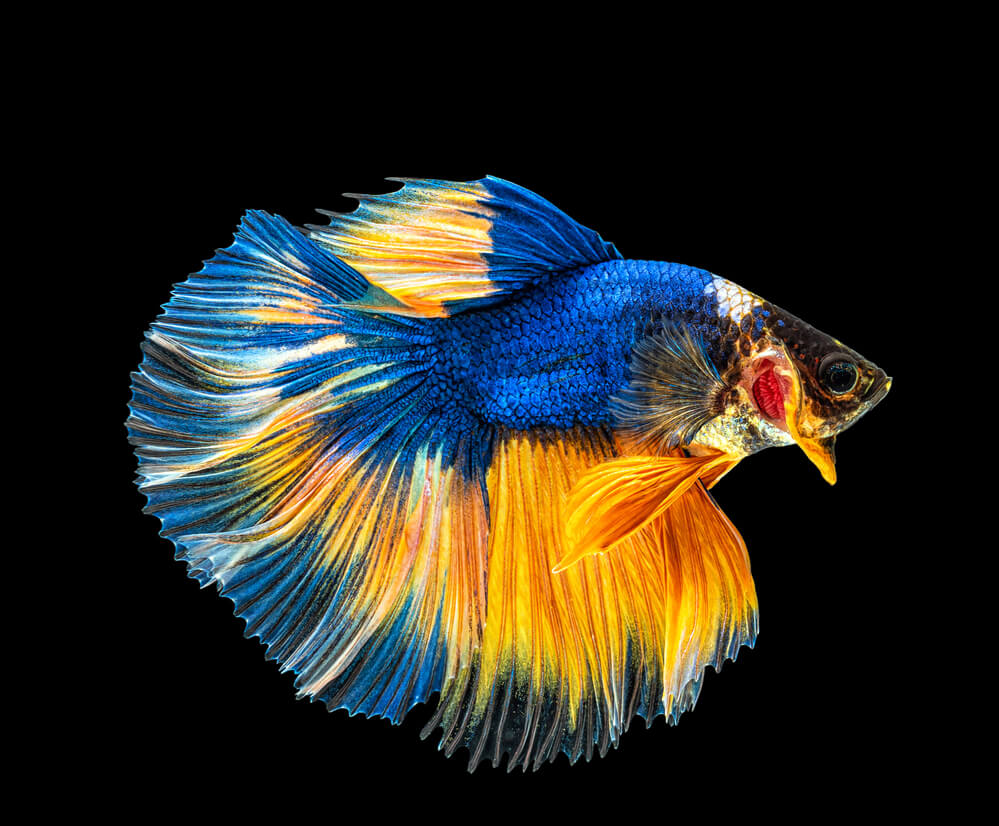
Halfmoon bettas are part of the betta splenden family and are usually the types of betta fish you see swimming in pet stores.
The halfmoon betta is one of the most popular types of betta fish because it has a beautiful design that makes its tail look like a half-moon.
Halfmoon Bettas are usually quite peaceful and loving pets, but they can be aggressive if they feel threatened or if their territory is invaded. They can live in tanks with specific tank mates, like cory catfish.
Peaceful betta (betta imbellis)

Peaceful bettas belong to the betta imbellis family and are cousins to the betta splenden. Although they have the word “peaceful” in their name, Peaceful bettas are still a slightly aggressive fish, but not as much as the halfmoon betta. Like other betta fish, two males cannot live together.
Tank mates for betta fish
Betta fish are social creatures and need companionship in order to feel happy.
While there are many types of fish that can be kept with a betta, it’s important to find one that is compatible—both in temperament and size—before adding them to the aquarium.
The best tank mates for betta fish are those that are similar in size and behavior. This means that you should avoid keeping any type of fish with a betta that is smaller or more aggressive than it. It is also important to make sure that the other fish have adequate filtration and drainage capabilities as betta fish can be finicky about their water conditions.
There are many different types of tank mates for betta fish, so it is important to choose the right one for your specific set-up. Some of the best tank mates for bettas include:
- Small corydoras
- Nerite snails
- Ghost shrimp
- Cherry shrimp
- Dwarf gouramis
- Other small peaceful fish like guppies
Make sure to research which type of fish is compatible with your betta before adding them to your tank!
If you’re new to owning a betta fish, it’s best to keep them in a tank by themselves at first. Once you know your betta’s personality, you can start introducing him or her to other fish in the tank.
Betta fish care
Caring for your betta fish might seem hard at first, but I want to break everything down so it’s nice and easy.
Tank size
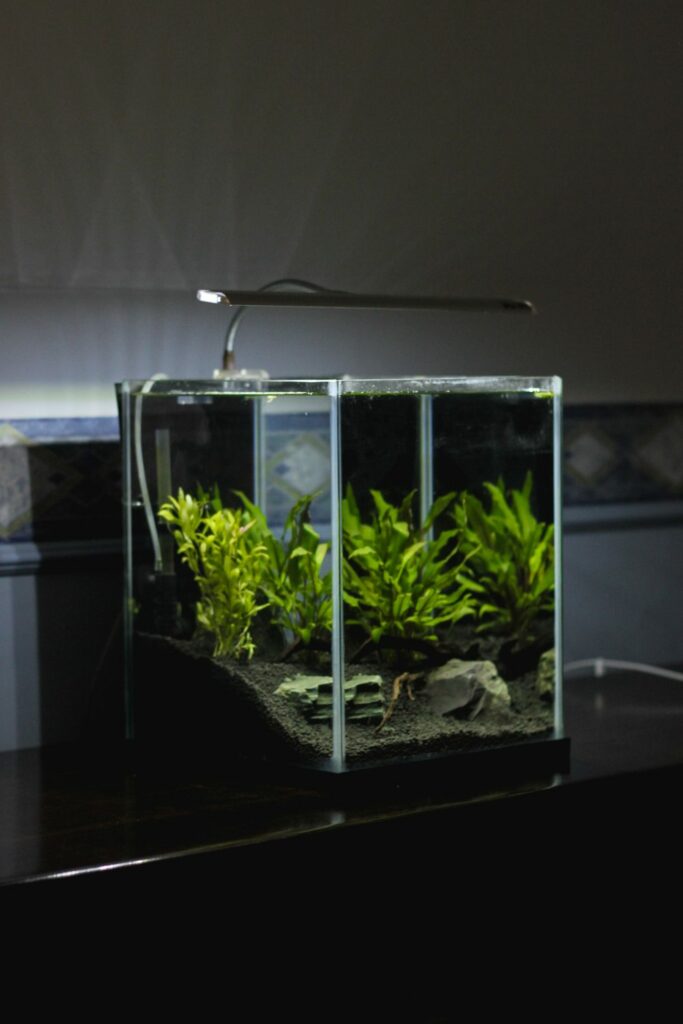
If you’ve ever been to a pet store, you’ll see betta fish swimming in small cups. Many people assume that because betta fish are sold in small cups, they don’t need large tanks to live.
This couldn’t be further from the truth.
A single betta fish needs a five gallon tank minimum—small cups and jars will simply not work.
Since betta fish enjoy hiding, you need to make sure your betta fish has plenty of hiding places. Just make sure to avoid adding any sharp plants or objects into the tank as they can damage your betta fish’s fins.
Water quality
To avoid poor water quality and toxin build up, make sure you ….. (what should they do?)
Cleaning your tank is essential. Things like uneaten food and fish waste can build up and create toxins and a dirty environment. If you don’t have a filter in your tank, change around 30%-50% of the water weekly. If you have a filter, you only need to change 20%. You should not change 100% of the water, otherwise your fish can go into shock. Do full tank cleanings every 6-8 months.
Water temperature
Keep the water between 75 to 80 degrees Fahrenheit for a halfmoon betta. If you are getting a different type of betta fish, talk to your breeder to see what water temperature is best.
How much to feed betta fish
Betta fish are small, active fish that require a small amount of food to maintain their health.
When it comes to feeding betta fish, there are a few things to keep in mind. The first is that all fish require a balanced diet of both protein and carbohydrates. Second, betta fish are especially fond of small live foods like worms, crustaceans, brine shrimp, and mosquito larvae. Finally, make sure the food you give your betta is fresh and free from harmful chemicals.
A regular feeding schedule for a betta fish should include two to four pellets per day, once or twice daily.
Here are some tips on how to feed your betta fish:
- Start by measuring out a small amount of food for each individual fish. Make sure the food is small enough for them to eat in one bite.
- Place the food where your betta can reach easily. Don’t hide the food and expect your betta to scavenge for it.
Giving your betta fish treats
Yes—betta fish like treats! You can substitute treats for their regular feeding one to two days per week if you’d like.
There are a variety of different treats that work well as betta fish snacks, so find what your fish loves! Some great options include freeze-dried bloodworms and insect larvae. Just make sure to keep an eye on your betta fish if you introduce treats into their diet. Like other animals, betta fish can gain weight from overfeeding.
Keep in mind that treats should only be given occasionally, and should not replace the regular diet of your betta fish.
Health issues
Bettas can suffer from a variety of health issues, some of which are relatively common in fish and some that are unique to bettas. Here is a look at the most common health issues faced by betta fish and what you can do to help prevent them.
Parasites
Bettas are prone to parasites, especially if they live in dirty tanks or water. Regular parasite treatment is important to keep your betta healthy.
Parasites can affect different areas of the body, including the digestive tract, skin, and internal organs. Many parasites are easily diagnosed by a veterinarian, but others may require laboratory tests to determine their exact species and location. There are several types of betta fish parasites, each requiring specific treatment. These include:
- Ichthyophthirius multifiliis: known as ich, this parasite causes white patches on the fish’s skin and scales
- Velvet: this parasite gives your betta fish a grey to golden coating on their body
Both of these parasites require you to act fast and get treatment, otherwise, your fish will die. If you aren’t sure how to treat your fish, call your vet or local pet store.
Algal blooms
Algal blooms are a common occurrence in freshwater fish tanks, and can be troublesome for both the fish and the owner.
Algal blooms are created when algae grows more rapidly than it can break down. The excess algae creates a thick scum on the surface of the water, which can clog filters and overflow from the tank. Sometimes algal blooms happen when you feed your fish too much food and there is too much phosphate present in the tank.
Algae will also produce toxins that can harm your fish. If you notice an algal bloom developing in your tank, start by reducing the amount of organic matter in the water and try to introduce beneficial bacteria to help clean up any toxins produced by the algae.
Stress stripes
Like any other animal, betta fish can experience stress in their lives. It can happen when they don’t like something that is happening, or when there is something unfavorable in their environment.
When this occurs, betta fish will typically show signs of stress by developing stress stripes on their body overtime. These stripes can vary in shape and size, but they usually run along the length of the betta’s body.
If you notice any signs of stress from your betta fish, it is important to take measures to help alleviate the situation.
It may take trial and error to understand why your betta fish is developing stress stripes. Start by looking at your tank size and the water parameters. Is the water too hot? Too cold? Is the pH level sufficient (betta fish thrive in tanks that are somewhat acidic or neutral, with a pH level of 6.8-7.5).
If everything is good, look at your betta’s environment. Do you need more hiding places for your betta? Understanding what’s stressing out your betta can take time, but once you figure it out, their stress stripes will begin to fade.
Price and cost of care
Betta fish themselves are quite cheap, with the average price for a betta fish is around $10-$15. It’s the tank that can be expensive, however. The average betta fish tank set up (for a ten gallon tank) can cost you upwards of $200.
You can always look for second hand tank and tank equipment, just make sure it works before introducing any fish into it.
The cost to take care of a betta fish varies depending on the size and type of aquarium you keep them in, but generally ranges from $10-$30 per month.
Betta fish behavior
Betta fish are known for their active nature, and can even jump out of your tank if they don’t like the environment. For that reason alone, it’s a good idea to have a covering on your betta fish tank just to ensure the betta fish stays inside the tank.
They are also known to be quite territorial and may become aggressive when they feel threatened, and will fight to the death if necessary.
One thing that makes betta fish unique is their ability to build bubble nests.
Bubble nests
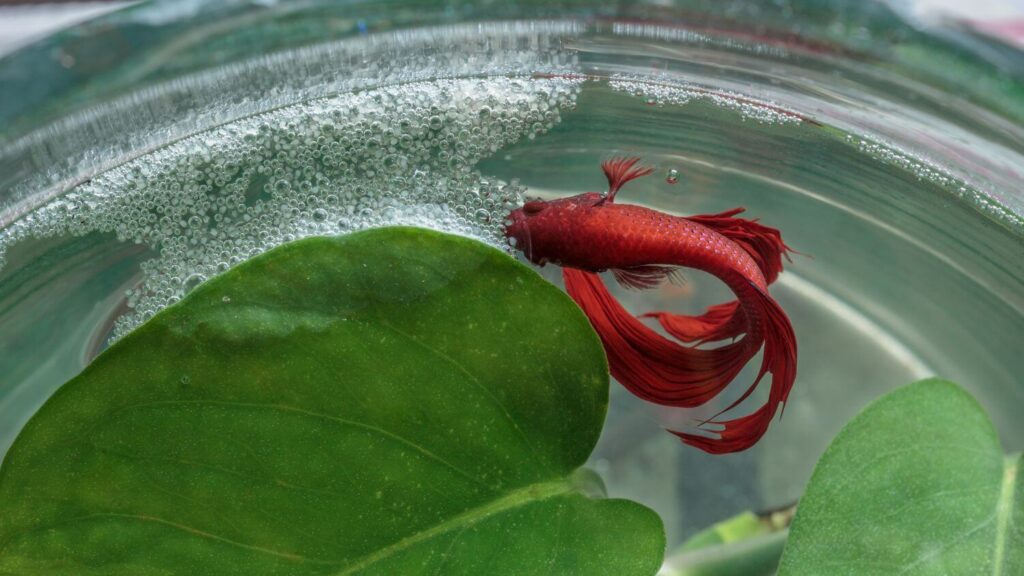
Betta fish are known for their bubble nests. They make them for themselves, as well as for when they lay eggs.
The bubble nest is made up of many small bubbles that are held together by a thin film of water. They are made out of bubbles to keep eggs enveloped in an oxygen-rich environment.
Many people wonder whether or not they should leave the bubble nests when they clean their tanks. If you can, leave the bubble nest while you clean the tank by working around it or scooping it out gently with a spoon to place back in. However, if you’re unable to leave the nest and must remove it to clean your tank, go ahead. Your betta fish can make a new one and needs a clean tank to survive.
How many betta fish can you keep in the same tank?
Many people ask me: can my betta fish live with other fish?
The answer is complicated, and because it’s so complicated, only experienced fish owners should keep multiple betta fish in a single tank.
Male bettas
You must only have one male betta fish in your tank, as multiple male bettas will fight with one another. If your tank is large enough, you can try adding a divider to keep multiple male bettas in one tank, however, they must not be able to see one another. You can get an opaque divider or cover it with plants so the fish cannot see one another.
Female bettas
When it comes to female betta fish, you can have more than one in a tank. It’s best if you can get sister betta fish so they already know each other and are less likely to get territorial.
Otherwise, you can have four to six female bettas in a ten gallon tank. No more, no less! No more because there can be overcrowding issues.
No less because there can be inferiority/superiority issues. For example, with two female bettas, one will always be superior and one will always be inferior. The superior one will attack the inferior one and can kill her. To keep the peace among your female bettas, always have at least four.
To add multiple female bettas into a tank, start with one. When that betta is used to the tank, add another one. Watch how they interact with one another for 30 minutes. If all is going good, add another. Watch the three for another 30 minutes. Keep doing that until all the females are added into the tank.
Keep a watchful eye on them for the next week, and if they get too aggressive, move them to separate tanks. They may nip at one another but make sure it doesn’t escalate past that. Make sure your bettas each have places they can hide and retreat to when they need their space.
Male and female bettas
You can keep male and female bettas together, however, you need a very large tank. I recommend at least 30 gallons if you want one male and one female betta fish.
Lifespan
Betta fish live around two to five years with proper care. If you adopt a betta fish, it may live a bit less since you don’t know what the care was like prior to adopting.
Bettas are tropical fish and as such, they are susceptible to diseases and parasites that can shorten their lifespan. Make sure to keep your betta healthy by providing a clean tank and offering an adequate amount of fresh food.
Are betta fish good pets?
Betta fish are not meant to be pets for children unless they have adult supervision, but with the right care, you can keep a healthy betta fish as a pet!
Are you thinking of getting a betta fish? Drop a comment below and let me know what color you’d like to get.

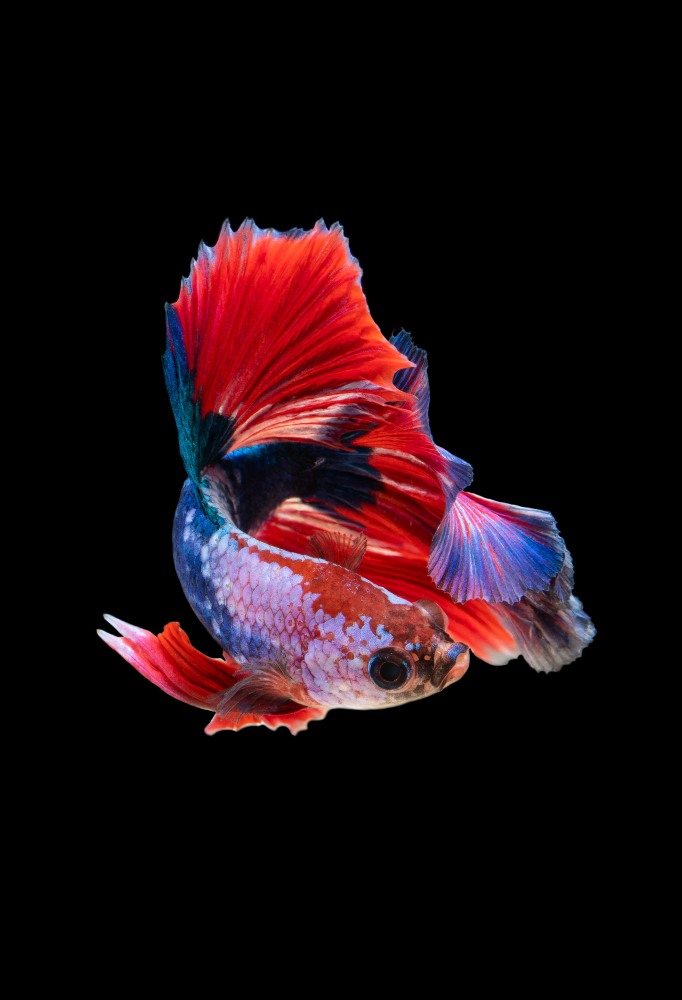
This article covers everything you need to know about Betta fish, so you can keep these beautiful creatures happy and healthy in your own home!